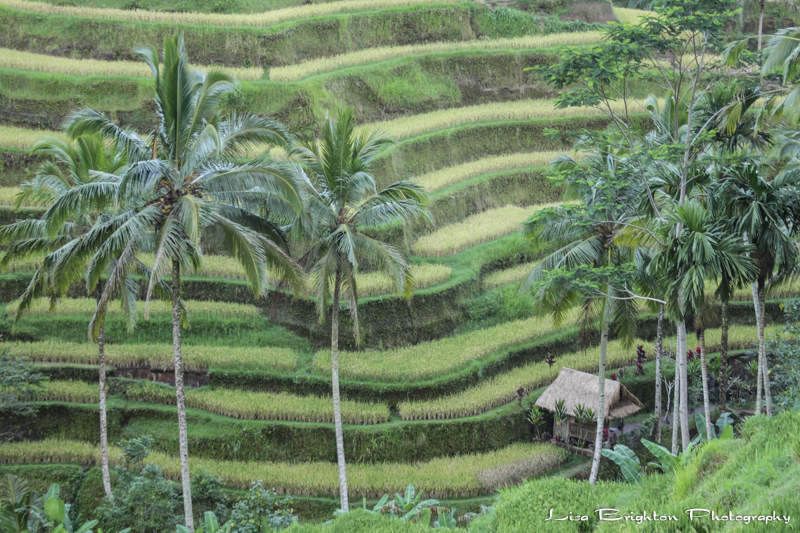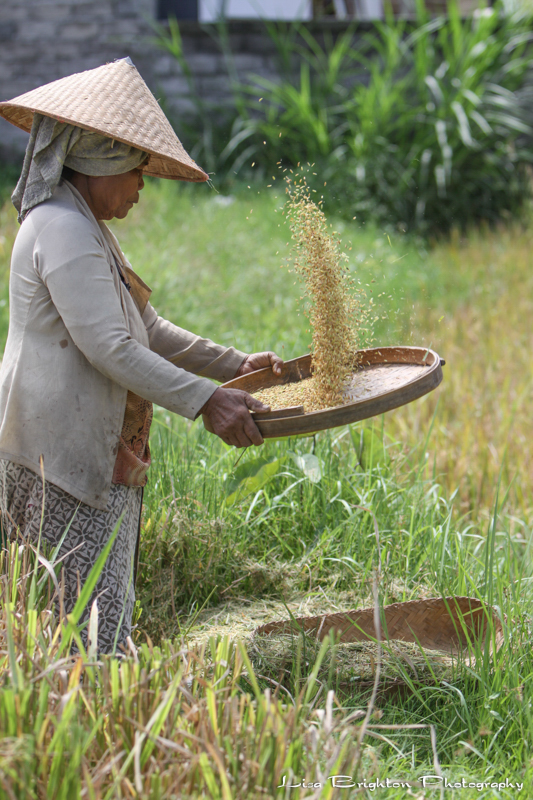6. Mr. Lucky
 “You’re sure that this is going to be alright?” I ask my Balinese guide, Mr. Lucky. “They won’t mind being photographed while they work?” “It will be fine,” he says calmly. “Just be mindful of your step and follow me.” I can’t believe I’m doing this… we’re doing this… hiking into a rice field… with my heavy camera gear draped around my neck… and after a two-hour early morning yoga class no less… I look at Mr. Lucky dressed in a traditional Balinese sarong, and wish I were wearing one. He doesn’t
“You’re sure that this is going to be alright?” I ask my Balinese guide, Mr. Lucky. “They won’t mind being photographed while they work?” “It will be fine,” he says calmly. “Just be mindful of your step and follow me.” I can’t believe I’m doing this… we’re doing this… hiking into a rice field… with my heavy camera gear draped around my neck… and after a two-hour early morning yoga class no less… I look at Mr. Lucky dressed in a traditional Balinese sarong, and wish I were wearing one. He doesn’t  seem to be fazed by the heat — or my request to do this photoshoot. I, on the other hand, am starting to wonder whether it was a good idea to trek out here in the mud, stifling heat and humidity. “Look! Look here,” he excitedly says. “It’s a black dragon fly.” I catch up to him and crouch down to look at this insect I’ve never seen before. “That’s pretty cool,” I say. “Look here,” he says. “There’s a red one.” “That’s incredible too.” I take a few images before we move on. “How hot do you think it is today, Mr. Lucky?” “Nearly 35,” he says continuing to walk as I do the math to convert the temperature to Fahrenheit. “That’s nearly 100 degrees!” He isn’t concerned because he never breaks a sweat. He moves quickly from the weather to explaining the irrigation system of a rice field and the process of growing rice. “The seedling is planted and harvested a mere 90 days later,” he explains. “The harvest takes only 90 days because the soil in Bali is rich and unfertilized, unlike soil that needs fertilizer in other parts of the world. Farmers can have three or four harvests a year. It’s good for the farmers’ income and good for Bali.
seem to be fazed by the heat — or my request to do this photoshoot. I, on the other hand, am starting to wonder whether it was a good idea to trek out here in the mud, stifling heat and humidity. “Look! Look here,” he excitedly says. “It’s a black dragon fly.” I catch up to him and crouch down to look at this insect I’ve never seen before. “That’s pretty cool,” I say. “Look here,” he says. “There’s a red one.” “That’s incredible too.” I take a few images before we move on. “How hot do you think it is today, Mr. Lucky?” “Nearly 35,” he says continuing to walk as I do the math to convert the temperature to Fahrenheit. “That’s nearly 100 degrees!” He isn’t concerned because he never breaks a sweat. He moves quickly from the weather to explaining the irrigation system of a rice field and the process of growing rice. “The seedling is planted and harvested a mere 90 days later,” he explains. “The harvest takes only 90 days because the soil in Bali is rich and unfertilized, unlike soil that needs fertilizer in other parts of the world. Farmers can have three or four harvests a year. It’s good for the farmers’ income and good for Bali.  Rice exportation dominates the economy here, but we also export coffee, tea and tobacco,” he says. I’m focusing on my footing, trying to make sure I don’t slip and fall from the very narrow strip of dry land between the muddy pools of water. Since this was my idea, the last thing I want is to make a spectacle by splashing into the water. Then it hits me… I’m making a spectacle out of myself by trekking out here to meet the rice farmers… I carefully glance up ahead and am relieved to see some of them smiling and waving to us. That’s a good sign… But then I see one woman who is looking at me like, who is this silly girl with the cameras coming all the way out here? Someone who is hoping to meet and photograph you, that’s who. We climb over mounds of soil and make our way to a dry clearing. The workers are peeling and sifting rice before putting it into large bags. We make friendly introductions, and Mr. Lucky asks if it is alright for me to take some photographs of them while they work. No one opposes, so I start clicking. It doesn’t take me long to realize that all the workers are women. I use my telephoto lens to scan the entire area, and I don’t see one man. “Mr. Lucky, it’s all women working here.” “Yes,” he says. “It often is.” I go back to taking images of the women as they cut, pile, sift, toss, shake and pack the rice. Once a bag is full, they hoist it over their head and carry it to storage. It looks like hard and dirty work, especially in this heat and humidity. But these women look unaffected. It makes me wonder how much they are paid and whether it’s by the bags of rice they fill or the time they work. We leave the rice field, and I’m grateful that I met them. They gave me a new perspective on how rice is transformed from a seedling to a dish on the dinner table.
Rice exportation dominates the economy here, but we also export coffee, tea and tobacco,” he says. I’m focusing on my footing, trying to make sure I don’t slip and fall from the very narrow strip of dry land between the muddy pools of water. Since this was my idea, the last thing I want is to make a spectacle by splashing into the water. Then it hits me… I’m making a spectacle out of myself by trekking out here to meet the rice farmers… I carefully glance up ahead and am relieved to see some of them smiling and waving to us. That’s a good sign… But then I see one woman who is looking at me like, who is this silly girl with the cameras coming all the way out here? Someone who is hoping to meet and photograph you, that’s who. We climb over mounds of soil and make our way to a dry clearing. The workers are peeling and sifting rice before putting it into large bags. We make friendly introductions, and Mr. Lucky asks if it is alright for me to take some photographs of them while they work. No one opposes, so I start clicking. It doesn’t take me long to realize that all the workers are women. I use my telephoto lens to scan the entire area, and I don’t see one man. “Mr. Lucky, it’s all women working here.” “Yes,” he says. “It often is.” I go back to taking images of the women as they cut, pile, sift, toss, shake and pack the rice. Once a bag is full, they hoist it over their head and carry it to storage. It looks like hard and dirty work, especially in this heat and humidity. But these women look unaffected. It makes me wonder how much they are paid and whether it’s by the bags of rice they fill or the time they work. We leave the rice field, and I’m grateful that I met them. They gave me a new perspective on how rice is transformed from a seedling to a dish on the dinner table.
